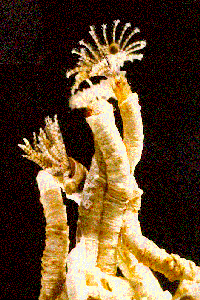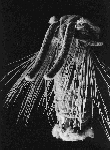People:
Joseph Pawlik
Graduate students
Information for undergrads and
prospective grad students
Science:
Marine chemical ecology
Giant barrel sponge Xestospongia muta
Marine invertebrate larval
biology
Photographic guide to sponges of the Caribbean
Courses:
BIO 318:
Invertebrate
Zoology
BIO 501: Science as a Profession
| HOME |

 |
 |
Settlement of Sandcastle Worms:
Marine polychaete worms of the family Sabellariidae live in tubes constructed of cemented grains of sand. Some species are gregarious and form colonies and reefs of amassed sand tubes. These colonies are entirely dependent on the recruitment of planktonic larvae for reef maintenance and growth (Pawlik & Faulkner, 1988). Larvae of Phragmatopoma californica, a gregarious sabellariid from the coast of California, settles on the sand tubes of adult conspecifics over other substrata. Sequential extraction of the tube sand of P. californica in a series of organic solvents diminished its capacity to induce larval settlement (Pawlik, 1986). Inductive activity was retained in the organic extracts of natural tube sand. An active fraction was isolated from the extracts by HPLC, and nuclear magnetic resonance spectrometry and gas chromatographic analysis of the fraction revealed that it consisted of a mixture of free fatty acids (FFAs) ranging from 14 to 22 carbons in length.
Extracts of worm-free tube sand from reefs formed by P. californica contained concentrations of FFAs sufficient to induce larval settlement (Pawlik, 1986). The FFA fraction isolated from the tube sand of Phragmatopoma californica contained predominantly eicosapentaenoic (20:5), palmitic (16:0), and palmitoleic acids (16:1). (In the shorthand notation for FFAs, the number of carbon atoms in the molecule precedes the colon, and the number of double bonds follows.) Of the nine FFAs that contributed 3% or more to the active fraction, only palmitoleic, linoleic (18:2), arachidonic (20:4) and eicosapentaenoic acids induced larval settlement. In further assays of an additional 28 FFAs of variable carbon chain length and unsaturation, it was discovered that larval response was stereospecific, with maximum settlement in response to palmitoleic, linolenic (18:3), eicosapentaenoic and docosahexaenoic (22:6) acids (Pawlik & Faulkner, 1986). Palmitelaidic acid, the trans isomer of highly active palmitoleic acid, was ineffective at inducing larval settlement. The capacity to stimulate settlement was linked to molecular shape, which was determined both by the number of carbon atoms and the number of cis double bonds in the acyl chain. For example, although palmitoleic acid (16:1) was a potent inducer of larval settlement, oleic acid (18:1) was not, due to its greater molecular length. Linoleic (18:2) and linolenic acids (18:3) were active, however, because the additional cis double bonds act to twist and shorten these molecules to an overall shape similar to that of palmitoleic acid. The induction of larval settlement by FFAs was also dependent on the presence of a free carboxyl group. Modification of the carboxyl terminus of the FFA molecule by esterification or reduction resulted in the loss of inductive activity (Pawlik & Faulkner, 1986). Therefore, larval response was dependent on the presence of at least one cis double bond in the molecule, conservation of molecular shape with increasing acyl chain length by addition of cis double bonds, and the presence of a free carboxyl group. This high degree of stereochemical specificity was likened to that described in studies of chemoreception by terrestrial insects (Pawlik & Faulkner, 1986, 1988).
Larval settlement responses of Phragmatopoma lapidosa, a gregarious sabellariid from the tropical western Atlantic, were very similar to those of P. californica (Pawlik, 1988b). Inductive capacity of the tube sand was lost upon extraction with organic solvents and the activity was retained in the extracts. Again, a suite of FFAs was isolated as the active component. The same FFAs that stimulated larval settlement of P. californica did so for P. lapidosa, and they were isolated from the natural tube sand of both species at about the same concentrations. The similarities did not end there: in addition to having identical larvae and adults, the two species were completely interfertile in reciprocal fertilisation experiments. The hybrid larvae of both crosses developed and metamorphosed normally, prompting the synonymisation of the two: Phragmatopoma lapidosa lapidosa for the western Atlantic subspecies, and P. l. californica for the eastern Pacific subspecies. Larvae of Sabellaria alveolata, a reef-building sabellariid from European waters, did not respond to the chemical signals that caused settlement of Phragmatopoma lapidosa californica (Pawlik, 1988a). In reciprocal assays, settlement of both species occurred to a greater extent on conspecific tube sand than on heterospecific tube sand. Extraction of the tube sand of Sabellaria alveolata with organic solvents diminished its capacity to trigger settlement of conspecific larvae, but activity was not transferred to the extracts, and an inducer was not isolated or identified. Furthermore, the FFAs that elicited settlement of Phragmatopoma lapidosa californica and P. l. lapidosa were either not effective at inducing settlement of Sabellaria alveolata or inhibited the response. Larvae of non-gregarious species from the Caribbean, S. floridensis, and from the eastern Pacific, S. cementarium, similarly did not respond to FFAs (Pawlik, 1988b; Pawlik & Chia, 1991). FFAs were present in the natural tube sand of S. alveolata at less than one-tenth the concentration found in natural tube sand of Phragmatopoma lapidosa californica and P. l. lapidosa, suggesting that adults of the two subspecies of Phragmatopoma produce the FFAs that induce conspecific settlement. Pawlik concluded that settlement of gregarious sabellariids is under the control of different chemical signals for species in different genera. The differences in larval responses to FFAs between species further suggested that a specific mechanism is responsible for the perception of FFAs by larvae of the two subspecies of P. lapidosa.
Larval settlement experiments performed in laboratory flumes have several major advantages over those performed in still water; in particular, the ability of larvae to select substrata in flow can be assessed. Phragmatopoma lapidosa californica has proven to be a very useful subject in experiments with flumes, because (1) larvae are large enough to be easily seen, (2) they undergo settlement rapidly, (3) metamorphosis results in major morphological changes, permitting the separation of larvae and metamorphosed juveniles in fixed samples, and (4) settlement is highly specific, occurring only on tube sand or sand treated with inductive compounds. Pawlik, Butman and Starczak (1991) conducted flume experiments at two flow regimes in which larvae of P. l. californica were offered a choice of five treatment substrata in a 5 x 5, latin-square array. In both flows, larvae settled preferentially on the two substrata that had induced settlement in still-water assays (tube sand and sand treated with palmitoleic acid). Surprisingly, delivery of larvae to the array was greater in fast flow, because larvae tended to move off the bottom in slow flow. Therefore, behaviour may be important in the settlement process at two levels for P. l. californica: larvae respond first to flow conditions and then, as they sample the substratum, to chemical cues.
References can be found by clicking HERE.
Biofouling by a gregarious polychaete:
Most fouling invertebrates form aggregations as larvae settle on or near adult conspecifics. While considerable research has focused on larvae that settle gregariously, little is known about the settlement responses of larvae that initially colonize the substratum -- the "founder" larvae that establish aggregations. As a collaborative project between the PI and Dr. Cheryl Ann Butman at Woods Hole Oceanographic Institution, we investigated the effects of substratum characteristics, heredity, and hydrodynamics on the responses of founder and gregariously settling larvae of a common macrofouling serpulid polychaete, Hydroides dianthus, with larval rearing and still-water experiments performed at UNCW, and flume experiments performed at WHOI. The first year of research at UNCW yielded unexpected results that were the basis for a MS thesis by Robert Toonen. In brief, experiments conducted with larvae spawned from individual female worms revealed that the majority of founder larvae (those that settled non-gregariously on biofilmed surfaces) settled within the first week after hatching, while their gregarious siblings (those that settled near conspecific adults) settled over the entire 10-wk experimental period and did not lose their substratum-specificity. Therefore, it appears that (1) founder larvae are distinct from gregarious settlers, and (2) aggregations are not established as a result of settling by "desperate" larvae.
References can be found by clicking HERE.
